[Editor’s Note: A few years ago, urban planner Nick Seivers imagined a monumental development organized around a new roundabout at the intersection of East Broadway and Baxter Avenue. With the gas station site on that corner up for lease, we asked Nick to update his plan with what he has learned in the ensuing years. Here is his original proposal with a new update on the project. View more of Nick’s proposals on his blog, Urban Composition.]
The Circle at Broadway and Baxter Avenue concept has been one of my more popular Urban Compositions since it first appeared on Broken Sidewalk in the winter of 2011-12. I have received overwhelmingly positive feedback on Broken Sidewalk, my website, and my social media when it has been shared over the years. A few have suggested that the concept take more care regarding the entrance to Cave Hill, existing structures, and tree canopy (I agree). Some have suggested that the roundabout concept eliminates trams and light rail possibilities on Broadway and Baxter Avenue (it hasn’t in similar settings elsewhere on the globe), others have suggested that this intersection would make a good transit hub (the complexity of this intersection currently makes transferring between transit lines difficult), and some that the buildings are too tall for the context (if I believed otherwise I would have drawn them with fewer floors in this proposal). The Move Louisville consultants quickly evaluated the roundabout portion of this concept and estimated that the roundabout would cost about $950,000 and would at least not make traffic worse through here. Of course, in all respects more study is needed.
A Circle at Broadway and Baxter is proposed for the grandeur and the sense of arrival, not necessarily for traffic management. A circle does, however, inform building shape and proportions. This isn’t just an intersection of roads, streets, and driveways, it is a place. A place not yet found in this young city. I suggest this form for both the public right-of-way and the new buildings upon the western side of Baxter Avenue. As cities mature, hopefully they get better. They recall and respect the past, experiment with new forms, build higher, build for the increasing complexity of the human city. There is conflict between old and new, and degrees of contrast and compatibility. It doesn’t have to all require planning or top-down intervention. The unintentional and the improvisation of space and building design is often more interesting and more successful. Successful places are adaptable. Louisville is growing up. We each have expectations for that growth. This is where coordinating land use and transportation investments could create something special.
This is an original concept on two major corridors on the east side of Downtown that I have made, that Broken Sidewalk has kindly shared, for Louisville to react to. I believe that the interest in this concept comes from our long and shared familiarity with this intersection. We have all been on our way through this intersection, or stuck in traffic, or confused in which way to go. It isn’t much of a place to be but we’ve all been there and may have had a few thoughts—if anything is to be done—on what should be done. A circle is a classical approach to city planning, it is symbolic, it means permanence and continuity. This concept is a reinterpretation, or a collage, of those great plazas and roundabouts we have seen in our travels, in postcards, and movies set in the world’s older cities. I think that this concept appeals to something that Louisville wants, doesn’t have, and hasn’t quite figured out how to adjust the levers so that design happens.
Without reconfiguring the intersection I would still suggest a crescent shaped building where the gas station is now located on the southwest corner of the intersection of Baxter and Broadway and a chamfered or convex radius on a new building on the northwest corner, each of about 6 stories. The structures and walls (of land uses unlikely to change) on the east side of Baxter Avenue are setback quite a bit from the intersection. Buildings on the west side of Baxter Avenue should mirror this setback and create a pocket to hold and define the place, to fill with activity. This proposal would require a variance from the code.
And now on with the plan: (Originally published on Broken Sidewalk on January 6, 2012.)
I took the opportunity over the holiday break to examine the design possibilities of a traffic circle, or roundabout, at the intersection of Baxter Avenue and Broadway. I arrived at a formal treatment of the space. This is a 50 year plan for the intersection that I would like to share with the Broken Sidewalk community.
To begin the exercise, I drew the traffic circle, or in this case an oval, that fills the space available at this intersection. The importance of the intersection and the demands of traffic circulation require a large roundabout. This design incorporates the entrance to Cave Hill Cemetery into the architecture of the new roundabout, while retaining enough area on the gas station lot to develop.

This is a volumetric exploration of the space. The buildings are designed to the scale of the space.
In this scenario, the block bounded by Baxter Avenue, Broadway, Rubel Avenue, and Rogers Street, is entirely re-imagined. The disregard of existing structures is partially because of the quantity of remaining structures (decreasing), the quality of remaining structures (decreasing), and the difficulty of designing around buildings from a distance. If the current structures are left to fend for themselves for the next several decades, given prevailing trends for this block, there may be few structures left worth incorporating into redevelopment designs. In any event, this scenario assumes a long horizon for completion. For this exercise, this block is a clean slate.
Structures, ranging from six stories in height at the roundabout down to two stories at the corner of Rubel Avenue and Rogers Street, frame the block. The buildings step down from Baxter Avenue to Rubel Avenue. On the interior of the block I have located parking decks a story above ground. If additional parking is necessary, I prefer it to be a story underground. For the most part, parking in this block is intended to serve the entertainment and commercial establishments in the district. Parking for residential units in this plan should be substantially less than the regional standard of two spaces per unit. The availability of transit and proximity to employment, entertainment, and other activities such as coffee shops and parks create an opportunity to reduce living area square footage and parking area (which would be a savings to both resident and builder). Many of the units in this block are intended to be attractive to those who wish to live close to the energy of the River City.
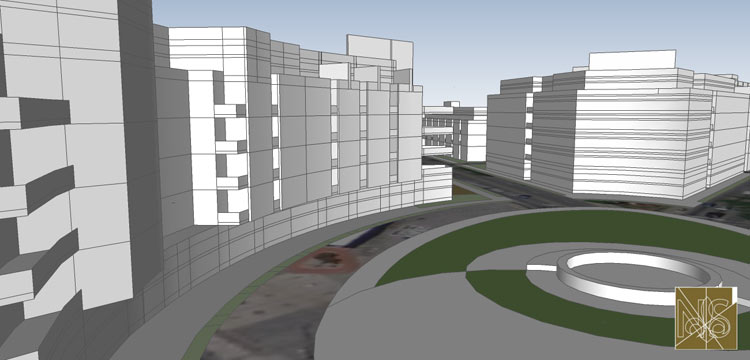
The centerpiece of this plan is the six story building that dramatically sweeps around the southwest side of the roundabout to a point at Broadway. This is a prestigious address. The building form reflects the stature of the improved intersection. So of course, in case there was any doubt of the rent in this building, a pool is located on the roof.
The prevailing characteristics of this plan include first, and sometimes second floor, non-residential uses including offices, boutiques and Phoenix Hill 2. New residents would find shops and restaurants just downstairs and all of the strengths of Phoenix Hill, Cherokee Triangle, and the Highlands just around the corner. Roof top amenity areas provide another escape close to the homes of the new residents. The rooftop retreats could include anything from a members only pool to a lounge chair and flower pot. Like most of the units, the rooftop doesn’t have to be fancy or elaborate to add to the concept. Most of the design detail is in the facade. The shape of the intersection informs the building layout. Once the shape of the circle was established – this is a cliche’ – the design emerged naturally. The buildings are designed to the scale of the space.

That concludes the Circle at Baxter and Broadway concept presentation. Assumptions and additional design details are discussed below.
The strength of my argument for a circle at this location is based largely in design. This is a formal treatment of a signature intersection in Louisville. The church, the cemetery entrance, the gas station, the warehouses, the night club are all set back from the intersection. None of the existing buildings face the intersection. This is a complicated intersection to think of filling-in with buildings. This is a complicated intersection for travel, as well.
A traffic circle will slow traffic through the intersection, but still allow traffic to move through the circle. The circle here is made as large as is possible to retain the Cave Hill Cemetery entrance to the east and a buildable lot to the west. The long sides of the ellipse are intended to extend the intersection to increase capacity. The long sides of the ellipse are also determined by the recommendation for this intersection where aesthetics also increase the real estate frontage on the traffic circle. The east side of Baxter Avenue will not change use or increase intensity. It is a park like setting that terminates Broadway. The design of the signature building takes advantage of the ellipse. Management of vehicles is an inescapable component of this concept, but design has an elevated and reciprocal role here.
I actually imagine that signals will still be needed with a traffic circle at this location. It is not possible to increase the distance between Baxter southbound and Broadway westbound, or Baxter northbound and Cherokee Road eastbound. That closeness may produce a conflict. Instead of a pure traffic circle, the redesigned intersection could work well with a hybrid between an intersection with diverter and a traffic circle. Only two signal changes would be necessary, illustrated below. The turns (two total) that are difficult with one signal are permitted with the alternate signal. A delayed signal to allow the two turns that have to yield in this arrangement could allow vehicles to clear the intersection before the signal changes. The forgiveness of the traffic circle component would still allow a few wandering vehicles to go around the circle.

Slower vehicle speeds would allow bicycles to operate in traffic. The continuous movement of vehicular traffic, however, will require some extra awareness of pedestrians in the intersection. The redesigned intersection should indicate to drivers that something special is ahead. The enclosure of the space should also indicate that they have arrived somewhere worth paying attention to. This is a good thing for the City, and travelers to or across the space by foot, bike, or car.
Ultimately, it is through design that I am attempting to convey a need to redesign the intersection. This fix includes aspects of city building that also include vehicular commuting.
On street parking is retained in most of the same areas where convenient, front door spaces are located currently. Additional spaces and loading zones are provided in the rear of the proposed structures. Parking decks above and below ground may also be necessary for residents and patrons of the Circle at Baxter and Broadway.
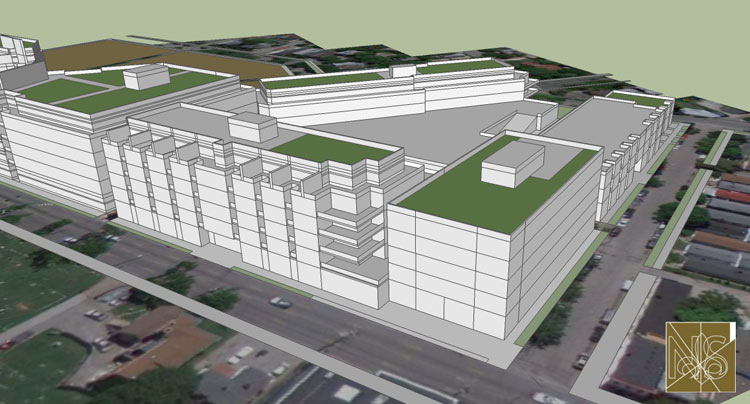
The auto filling and service establishments, like all current tenants of the plan area could be included in any redesign. A new Phoenix Hill Tavern could open in the same location as the current location. Besides the update to the venue, it could benefit from additional openings to the street like those of the Irish themed establishments further south.
Some of the frontage of Cave Hill Cemetery will be borrowed to complete the ellipse at this intersection. As far as I am aware the most significant features here are the low limestone wall, the iron fence, and the mature trees. I don’t believe – but I do not know – that historic designations or other artifacts will be disturbed if this area is redesigned. The trees are mature and could fail or require management long before this project is completed. The trees are disproportionately dense for the space. They obscure the entrance to Cave Hill and block out the sun. Filtered sunlight and managed landscaping would have a better effect at the edge of an urban space. I suggest with this plan that the wall and fence are moved back to create a small plaza to respond to the space on the north side of the church on the circle. Cave Hill would be accessed directly from the new roundabout with signed yields.
Windows, ornamentation, and street trees are not shown in this sketch. Visualizations of the Circle at Baxter and Broadway were created using Google Earth and Google Sketchup by Nicholas Seivers, Urban Composer.

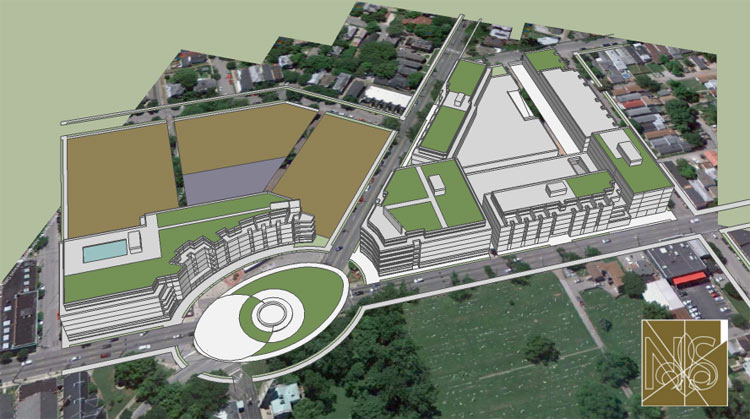


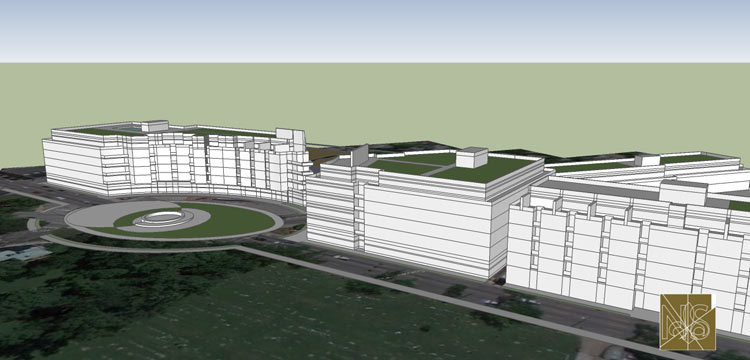

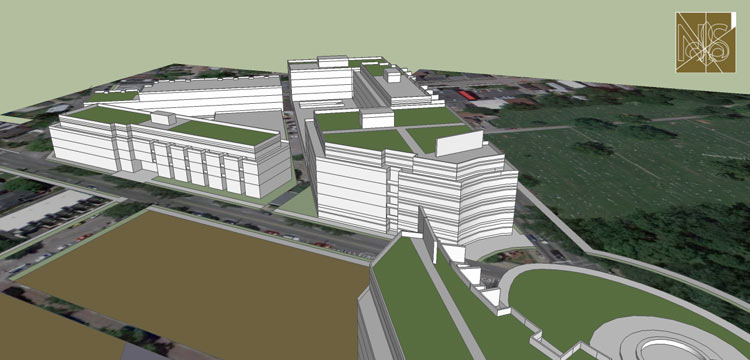





Looks like a great idea, I drive through that intersection every day, but this doesn’t address the issue of the significant bottleneck on Baxter between Broadway and Bardstown.
Great on paper.NIGHTMARE IN REALITY.
GO DOWN TO BARRET AND MAKE THE ROUNDABOUT.